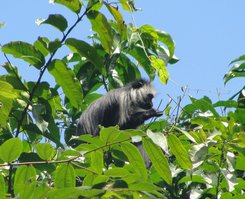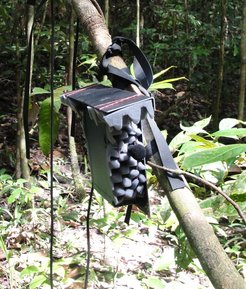Eavesdropping on the forest to monitor wildlife
Researchers develop a novel passive acoustic monitoring (PAM) method for the automated detection of chimpanzees and two monkey species
Traditionally, censusing of wild primates has been conducted using transect methodology where teams of human surveyors walk kilometers of line transects to collect data on primate sightings and vocalizations. Motivated by the increasing availability of cost-efficient audio-visual technologies, researchers at the Max Planck Institute for Evolutionary Anthropology in Leipzig, and the Fraunhofer Institute for Digital Media Technology (IDMT) in Ilmenau, investigated to what extent autonomous recording devices, combined with an automated data processing approach, could be used to monitor wild forest primates. To achieve this goal they used an interdisciplinary team of sound engineers, biomonitoring specialists, statisticians, and primate vocalization experts.

A system was developed in collaboration with the Fraunhofer IDMT, to automatically scan large amounts of continuous audio data to isolate sound signals produced by chimpanzees and two other primate species living in the tropical rainforest of Taï National Park in Côte d’Ivoire. The researchers used autonomous recording devices (ARUs) produced by the company Wildlife Acoustics. First, a training library of annotated primate sounds was compiled. “The algorithm was then developed to scan forest recordings and automatically detect and classify the chimpanzee buttress drumming sound and the loud calls of the diana monkey and king colobus monkey”, says Ammie Kalan, the project leader.
The researchers then applied this algorithm and verified how often it falsely detected a call (false positive) or failed to correctly identify a call (false negative). Using an occupancy modeling approach, they then derived occupancy probabilities for each of the three primate species, also known as the probability with which a species is present in a given study area. The occupancy probability estimates derived from PAM data approximated those obtained from point transects conducted in the same area by humans. In particular, the longitudinal data obtained using PAM appeared to be especially beneficial for accurately detecting chimpanzees since they are cryptic and often remain quiet when in the presence of humans. For all three species, probabilities were robust to the automated PAM data but some degree of manually verifying the automated output was still required. Nevertheless, the time effort required to clean some of the data manually was still considerably less than the time investment for walking transects.

“Our results show that for the best performing species with this system, the king colobus monkey, accurate occupancy probabilities could be derived by just cleaning 90% of the false positives, which translates to 23 minutes for 179 hours of audio data”, says Ammie Kalan.
“This study only shows the first step that is possible with this method. In principle, the system could be used for long-term monitoring whereby changes in presence or detection rates could be used as an early warning system to alert field managers and to help them respond to threats”, says project supervisor Hjalmar Kühl.
“The importance in using autonomous data collection devices, such as ARUs, along with automated data processing methods lies in obtaining data about wild animals closer to real-time rather than months or years later. Field workers can then react more quickly, allowing interventions to become more effective”, says Ammie Kalan.
The authors hope this study will motivate further cross-disciplinary research into PAM and its potential to aid field workers in managing the last strongholds of endangered primate populations, as well as other taxa.
[AK, HK]

